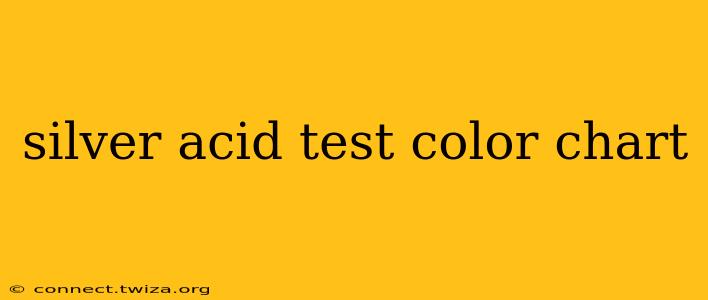The silver acid test, also known as the nitric acid test, is a common method used to determine the purity of silver. It involves reacting a small sample of silver with concentrated nitric acid (HNO₃). The resulting reaction and the color of the solution provide clues about the silver's composition. However, it's crucial to remember that this test provides an indication of purity, not definitive proof. More sophisticated methods are required for precise quantification.
This guide will explore the various color changes observed during a silver acid test and what they indicate. We will also address common questions surrounding this method.
What are the Different Colors in the Silver Acid Test and What Do They Mean?
The color of the solution after the reaction with nitric acid is the key to interpreting the results. Keep in mind that the intensity of the color can also be indicative of the amount of impurities present.
-
Clear, colorless solution: This is the ideal result, suggesting that the silver sample is relatively pure. The reaction of pure silver with nitric acid produces silver nitrate (AgNO₃), which is colorless in solution.
-
Light green or greenish-blue solution: A faint green or greenish-blue hue often suggests the presence of small amounts of copper. Copper reacts with nitric acid to form copper(II) nitrate, which is blue-green. The presence of copper implies that the silver is not pure, but the amount of copper contamination is relatively low.
-
Dark green or blue-green solution: A more intense green or blue-green color indicates a higher concentration of copper impurities in the silver sample. This suggests a significantly lower purity of silver than in the previous cases.
-
Brown or yellowish solution: These colors often indicate the presence of other base metals, such as gold or iron. Gold will not dissolve readily in nitric acid; the presence of gold could manifest as a dark precipitate, whereas iron impurities result in brownish hues due to the formation of iron nitrate.
-
No Reaction/Black Residue: If there is no reaction or a black residue remains, the sample might be composed largely of materials that don't react with nitric acid, or could contain significant amounts of base metals or alloys that resist dissolution. This indicates that the material is not primarily silver.
What is the difference between a positive and negative silver acid test?
A positive silver acid test is characterized by the dissolving of the silver sample in nitric acid, producing a solution with a discernible color change (as described above). A negative silver acid test means the sample doesn't react with nitric acid or produces minimal visible changes. This usually indicates the material is not predominantly silver.
Can other metals besides silver and copper react with nitric acid?
Yes, many other metals react with nitric acid, resulting in various colors depending on the metal. Some common examples include:
- Copper (Cu): Forms a blue-green solution.
- Iron (Fe): Forms a brownish solution.
- Gold (Au): Generally doesn't dissolve readily in nitric acid.
- Platinum (Pt): Generally doesn't dissolve readily in nitric acid.
What are the safety precautions for performing a silver acid test?
Nitric acid is a highly corrosive and dangerous substance. Always wear appropriate personal protective equipment (PPE), including safety glasses, gloves, and a lab coat. Conduct the test in a well-ventilated area or under a fume hood to avoid inhaling the fumes produced. Dispose of the waste properly following local regulations.
Is the silver acid test a definitive test for purity?
No, the silver acid test is a preliminary test providing an indication of purity. More sophisticated techniques like X-ray fluorescence (XRF) or atomic absorption spectroscopy (AAS) are needed for accurate quantitative analysis of silver purity.
What is the reaction of silver with nitric acid?
The reaction of silver with nitric acid is an oxidation-reduction reaction. Silver is oxidized, losing electrons, and nitric acid is reduced, gaining electrons. The overall reaction can be summarized as:
3Ag(s) + 4HNO₃(aq) → 3AgNO₃(aq) + NO(g) + 2H₂O(l)
This produces silver nitrate (AgNO₃) in solution, which is colorless, and nitric oxide gas (NO).
Remember to always prioritize safety and handle nitric acid with extreme care. This information is for educational purposes only and should not be interpreted as professional advice.
